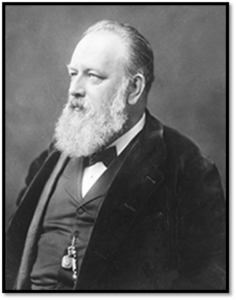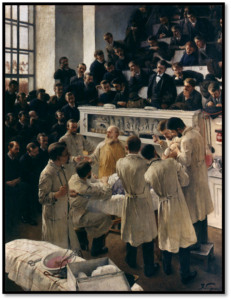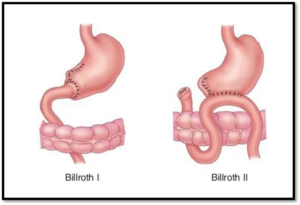Short Review – Historical Article
Miltiadis Perdikakis,1 Dimosthenis Papadimitrakis,1 Dimitrios Filippou2,3
1 School of Medicine, National and Kapodestrian University of Athens, Athens, Greece
2 Research and Education Institute in Biomedical Sciences (REIBS), Pireaus-Athens, Greece
3 Dept. of Anatomy, School of Medicine, National and Kapodestrian University of Athens, Athens, Greece
Corresponding Address: Miltiadis Perdikakis, National and Kapodistrian University of Athens School of Medicine, Athens,
Greece, miltiper@gmail.com
Abstract
Christian Albert Theodor Billroth (1829-1894) is a prominent figure in the history of surgery and medicine in
general. His operational innovations serve as pivotal advancements, as they introduced certain approaches that
changed the medical landscape. This paper provides a concise overview of his life, academic career, surgical
innovations, teaching skills, and prestigious awards. His remarkable musical talent is also discussed. Our goal is to justify his prominent status among the most influential physicians in history and to provide a distinct example of dedication to medicine.
KeyWords: Billroth, surgery, history of medicine
The history of medicine is adorned with numerous physicians, both known and unknown, who dedicated their lives to science. It is the duty of historians to accord them a place in history worthy of their names and actions. One of the most prominent physicians, a pioneering surgeon who laid the foundations for modern surgical practices, is Christian Albert Theodor Billroth (1829-1894) (Figure 1). Thanks to his medical achievements, Billroth’s name remains in the pantheon of surgeons who elevated medicine to a higher level of efficiency and professionalism. It serves as a reminder of the obligation that younger generations of physicians owe to those who paved the way for modern medicine.
His life
Christian Albert Theodor Billroth was born on the 26th of October 1829, in “Bergen auf Rügen” in the “Königreich Preußen” (Kingdom of Prussia), which was part of the German state of Prussia and lasted from 1701 to 1918. Information about his childhood is scarce and can be found in a short autobiographical essay. Billroth’s father was pastor Karl Theodor Billroth, and his mother was Christine Billroth (Nagel). Theodor was the oldest of five brothers. Their grandparents’ ethnic background was Swedish and French. His pastor father passed away from tuberculosis when he was only five years old, so he moved with his mother and brothers to Greifswald, where they had friends and relatives [1].

Figure 1: Christian Albert Theodor Billroth (1829-1894) (From: https://www.billrothhaus.at) |
Theodor Billroth completed his schooling in Greifswald. He began his medical studies in 1848 and studied at the universities of Greifswald, Göttingen, and Berlin. He earned his doctorate from Berlin’s University in 1852 by presenting his thesis, “De natura et causa pulmonum affectionis que nervo utroque vago dissecto exoritur” (The nature and cause of pneumonia caused by cervical vagotomy). After spending one year visiting the medical schools of Paris and Vienna, he returned to Berlin, where he acquired the position of assistant to Bernard Von Langenbeck (1810-1887), a prominent figure in surgery, at Berlin’s University Surgical Clinic [2,3]. He started publishing and lecturing on surgery as well as giving practical surgical demonstrations (Figure 2).

Figure 2. Theodor Billroth operating (From:: https://en.wikipedia.org) |
In Berlin, he met Christel Michaelis, whom he married in 1858. They had three daughters and one son. As his body of work expanded, he was appointed as a Professor of Surgery and the director of the surgical hospital in Zurich in 1860. In 1867, he was named a Professor at the University of Vienna and was appointed director of the 2nd Surgical Clinic at the city’s hospital. It was in Vienna where he reached the pinnacle of his medical career and continued to work until his passing in 1894 [4].
Apart from his surgical achievements in later life, Theodor Billroth had a special aptitude for music. He would have pursued this field, had it not been for his mother’s persuasion due to financial constraints, which led him to study medicine. He was proficient in multiple musical instruments, directed an orchestra, wrote music critiques, and formed friendships with musical composers [5]. He himself composed music in his younger years. Notably he left behind the first two chapters of a theoretical book on music titled “Wer ist Musikalisch?” (Who is musical?), which had already gone through four editions until 1912 [6]. It is not an exaggeration to say that his musical skills were an early indication of his future success in the field of surgery. One can only speculate what his accomplishments in music would be, had he followed the path that fate opened him early on.
Academic work and medical innovations
Billroth’s imprint on surgery and medicine as a whole cannot be easily overlooked. His work included numerous lectures, practical demonstrations, and important scientific treatises. However, his most precious legacy to medicine was his groundbreaking surgical procedures, some of which were successful and paved the way for the immense development of surgery. Billroth’s name is forever associated with some of surgery’s most famous procedures. He is also rightfully regarded as the founding father of modern abdominal surgery. However, his contributions extended beyond abdominal surgery.
Billroth performed his first operation in 1852, which was a herniotomy. While at the Von Langenbeck clinic, he published numerous scientific articles on various topics, including the histology of the spleen, mucous polyps, tumors, and blood vessels. In 1858, during the war between Prussia and France, he shifted his focus to the management of gunshot wounds. Subsequently, he expanded his interest to the diseases that could develop from open wounds and how to prevent their outcomes. He hypothesized that a microorganism was responsible for these diseases, a hypothesis that was later confirmed [7]. During his time in Zurich, he produced his most significant written work, the famous textbook “General Surgical Pathology and Therapeutics”, which went through 16 editions and was translated into 10 languages. He also greatly contributed to the composition of the massive series of the “Handbuch der allgemeinen und speciellen Chirurgie mit Einschluss der topographischen Anatomie, Operations und Verbandlehre” (Handbook of general and special surgery with inclusion of topographic anatomy, operation and bandage instruction). Furthermore, one of his greatest achievements was his effect on the use of statistics. He insisted that this was the only way to scientifically compare surgical and conservative treatment methods. He therefore recorded for years the outcomes of his treatments. He strongly suggested that it was an imperative for Germany at the time that the physicians adopted this method [8].
In 1872 Billroth performed the first successful esophagectomy and in 1873 he conducted the first total laryngectomy. He pioneered many surgical procedures, including the first subtotal colectomy. His first successful partial gastrectomy on a patient with cancer of the jejunum introduced the renowned Billroth I gastrectomy, in which the partially resected stomach is connected to the duodenum. Subsequently, he successfully performed a technique in which a partial gastrectomy is followed by the connection of the stomach to the jejunum. This procedure has been established as the Billroth II procedure (Figure 3) [9]. Throughout his medical career, Billroth was known for publishing both his positive and negative surgical outcomes. He believed that the improvement of medical procedures was more important than an unblemished reputation. In one of his opening lectures he stated: “He who cannot quote his therapeutic experiences in numbers is a charlatan; be truthful for clarity’s sake, do not hesitate to admit failures as they must show the mode and places of improvement” [10].

Figure 3: Billroth I and II procedures (source: https://gr.pinterest.com/pin/296182112990308318/)
|
Another area of intense involvement for Billroth was thyroidectomy. Thyroidectomy was considered for centuries a deadly operation due to its complications, and many physicians refused to practice it. Billroth was the first, along with his pupil Theodor Kocher (1841-1917), to reopen this forbidden chapter of surgery. His early outcomes were not ideal, resulting in 16 deaths after 36 thyroidectomies. After a few years and under better antiseptic conditions he managed to reduce the mortality rate to 8.3% after 48 such operations [11]. However, the consequences of the removal of the parathyroids, including tetany, were dramatic and saddened the physicians. Billroth’s pupils managed to mitigate this problem over time by preserving specific parts of the thyroid gland. This serves as a reminder that the science we admire today has often been accompanied by pain and suffering on its path of evolution.
Billroth’s name also emerges in multiple medical terms, since he was the first to identify the respective entities. For example, the “cords of Billroth” describe the splenic cords of lymphoid cells, that constitute the tissue between the venous sinuses of spleen. They are found in the red pulp and play a major role in the organ’s physiology and pathophysiology, since they expand in blood disorders that lead to splenomegaly [12]. Two diseases also carry the surgeon’s name. Billroth’s disease I is a pediatric disorder in which cerebrospinal fluid accumulate under the child’s scalp and Billroth’s disease II is a malignant lymphoma. It is worth mentioning that the latter has not been considered a surgical disease since Billroth’s time [13,14]. “Billroth’s venae cavernosae” are small tributaries of the splenic vein in the pulp of the spleen and the Buerger’s-Billroth’s disease is a chronic inflammatory disease that affects the peripheral vessels, mostly the radial and ulnar arteries [15].
Billroth was known not only as a unique surgeon, but also as a methodical teacher. Despite his fame and authority, he displayed a well-documented passion for the training of young physicians. It was acknowledged by many of his students and colleagues. In fact, it is worth noting that he even wrote an entire book on the subject of medical training. It was named “Über das Lehren und Lernen der medicinischen Wissenschaften an den Universitäten der deutschen Nation” (Teaching and Learning the Medical Sciences in the Universities of the German Nation) [16]. He explained there, among others, the virtues of a good physician, such as being a scientist, being resilient, being an athlete (!) etc. To sum up, his position as a Professor did not prevent him from fulfilling with conscientiousness his teaching duties.
Awards
Theodore Billroth accumulated a variety of awards throughout his life, dedicated to his medical services. He was appointed as Imperial and Royal Aulic Councilor and Professor as well as President of the Imperial and Royal Medical Association of Vienna. He was furthermore appointed to the Austrian “Herrhaus” (House of Lords) [17]. This was a distinction rarely attributed to physicians. He was also elected member of the “Deutsche Akademie der Naturforscher Leopoldina” (German National Academy of Sciences Leopoldina).
Conclusions
Theodore Billroth died on February 6, 1894, from a medical complication related to the thesis he presented for his doctorate. Perhaps one of Billroth’s most noteworthy accomplishments is the enduring memory he has left behind. He is not only remembered as a historic figure, but also as a vibrant legacy in medicine. Some of his techniques are still in use today. This is all the more remarkable, considering that in the century since his death, medicine has achieved significant advancements, fundamentally altering many of its historical practices.
Vienna, the city where Billroth achieved the pinnacle of his medical career, continues to honor him with the Theodor Billroth Prize. This prestigious award, presented by the medical association of Vienna, recognizes outstanding achievements in medical research and stands as one of the highest honors in the field in Vienna.
Conflicts of interest
All authors of this study have not any personal conflicts of interest or any financial conflicts of interest.
References
- Gersuny R. Theodor Billroth. Springer Vienna; 1922. https://doi.org/10.1007/978-3-7091-5384-0
- The Editors of Encyclopedia. Theodor Billroth. Brittanica. Published April 22, 2023. Accessed December 8, 2023. britannica.com/biography/Theodor-Billroth
- Billroth T. Obituary. Br Med J. 1894;1:335. https://doi.org/10.1136/bmj.1.1728.335
- Kazi R, Peter R. Christian Albert Theodor Billroth: Master of Surgery. J Postgrad Med. 2004 Jan-Mar;50(1):82-3. https://www.jpgmonline.com/text.asp?2004/50/1/82/6666
- Koay J. Pioneers of Surgery: Theodor Billroth. Surgical Interest Group. Published May 5, 2021. Accessed December 8, 2023. https://sigmum.org /2021/05/05/pioneers-of-surgery-theodor-billroth/
- McLaren N, Thorbeck R. Little-known aspect of Theodor Billroth’s work: his contribution to musical theory. World J Surg. 1997 Jun;21(5):569-71. https:// link.springer.com / article / 10.1007 / PL00012287
- Kwan H, McLaren R, Peterson T. The life and times of a great surgeon: Theodor Billroth (1829-1894). J Invest Surg. 2001 Jul-Aug;14(4):191-4. https://www.tandfonline.com/doi/abs/10.1080/089419301750420223
- Allgöwer M, Tröhler U. Biographical note on Theodor Billroth. Br J Surg. 1981 Oct;68(10):678-9. https://academic.oup.com/bjs/article-abstract/68/10/678/6185703?redirectedFrom=fulltext&login=true
- Kyle R, Steensma D. Christian Albert Theodor Billroth: Founder of Abdominal Surgery. Mayo Clin Proc. 2018 Mar; 93 (3): 29- 30. https: // www. sciencedirect. Com / science / article / pii / S0025619618300375 ?via%3Dihub
- Armenia S, Latzko M. The wisdom of Theodor Billroth: Lessons for today’s surgeons. American College of Surgeons. Published October 16, 2016. Accessed December 8, 2023. https://www.facs.org/media/1lchc3up/13_billroth.pdf
- Sarkar S, Banerjee S, Sarkar R, Sikder B. A Review on the History of ‘Thyroid Surgery’. Indian J Surg. 2016 Feb;78(1):32-6. https://www.ncbi.nlm. nih.gov/ pmc/articles/ PMC4848216/
- Arber D. Modern Surgical Pathology. 2nd ed. Elsevier; 2009. https://www.sciencedirect.com/ book/9781416039662/modern-surgical-pathology
- Kazi R, Peter R. Christian Albert Theodor Billroth: Master of Surgery. J Postgrad Med. 2004 Jan-Mar;50(1):82-3. https://www.jpgmonline.com/text.asp?2004/50/1/82/6666
- Singer H. Primary, Isolated Lymphogranulomatosis of the Stomach. Arch Surg. 1931;22(6):1001-1017. https://jamanetwork.com/journals/jamasurgery/article-abstract/540505
- Kleinert R, Reichenhall B. Christian Albert Theodor Billroth. Whonamedit?. Accessed December 8, 2023. https://www.whonamedit.com /doctor.cfm/2343.html
- Gonzalez-Urquijo M. Takeaways from a hundred and fifty years of surgical education: A chief resident’s perspective Lecciones de ciento cincuenta años de educación en cirugía: perspectiva de un jefe de residentes. Educ Méd. 22:514–516. https://www.elsevier.es/es-revista-educacion-medica-71-articulo-takeaways-from-hundred-fifty-years-S1575181320301807
- Kwan H, McLaren R, Peterson T. The life and times of a great surgeon: Theodor Billroth (1829-1894). J Invest Surg. 2001 Jul-Aug;14(4):191-4. https://www.tandfonline.com/doi/abs/10.1080/089419301750420223
